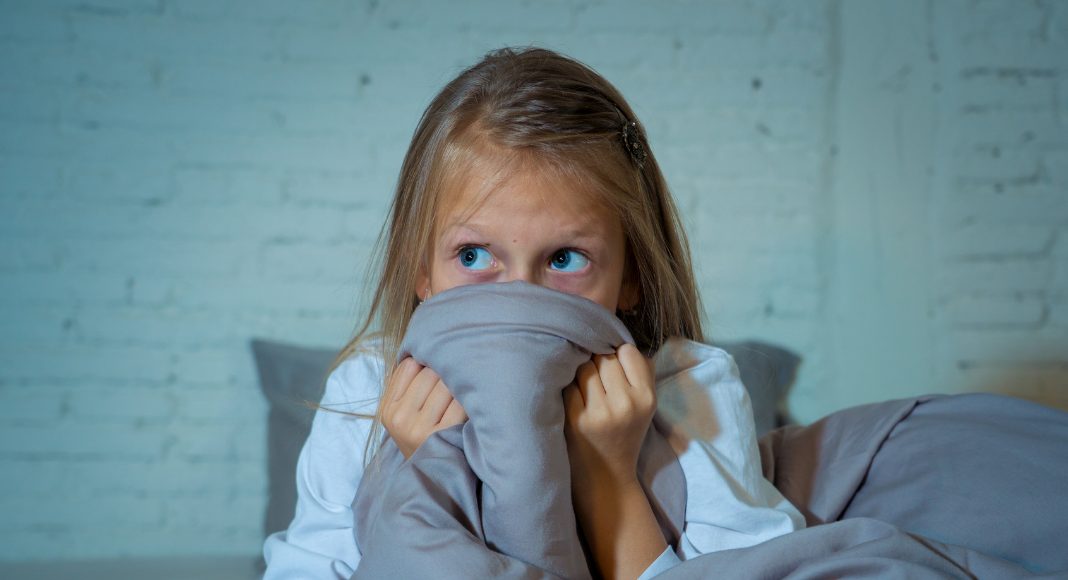 Your child is sleeping peacefully when you suddenly hear a blood-curdling scream. You race into their room and find them sitting up in their bed. Their eyes are wide open, they’re sweating, and they have an odd, almost “possessed” look on their face. You reach out to comfort them, but they push you away and scream louder. They don’t recognize you. They actually seem terrified of you! You assume that they’re having a nightmare and try to wake them up, but the more you try, the worse things get.
Your child is sleeping peacefully when you suddenly hear a blood-curdling scream. You race into their room and find them sitting up in their bed. Their eyes are wide open, they’re sweating, and they have an odd, almost “possessed” look on their face. You reach out to comfort them, but they push you away and scream louder. They don’t recognize you. They actually seem terrified of you! You assume that they’re having a nightmare and try to wake them up, but the more you try, the worse things get.
Nothing you do is helping, and you’re starting to panic. You reach for the phone to call the pediatrician, but before you dial the number, your child suddenly calms down. They stop screaming; their body relaxes, they yawn, lay down, and fall back to sleep as if nothing ever happened. Your child sleeps peacefully for the rest of the night, but you’re so rattled that you don’t sleep a wink. WHAT JUST HAPPENED?
What are sleep terrors?
Sleep terrors are sleep disturbances that occur when your child is transitioning from one non-REM sleep cycle to the next. They typically occur during the first four hours of sleep but may occur at any time throughout the night – and during nap time as well. They can last anywhere from 5 to 45 minutes (and occasionally even longer). Terrors can be a one time only event or occur nightly for several weeks at a time. 6 to 8 percent of healthy, happy children will experience a sleep terror sometime during their childhood. They tend to run in families. Sleep terrors by themselves are not an indication that your child has an emotional or medical problem.
Children transition in and out of sleep cycles frequently throughout the night. Typically, these transitions occur quickly and smoothly – you’ll know they’re happening because your child may open their eyes momentarily, move around a bit, mumble, chew or make sucking noises, and then settle down again quickly as they enter their next sleep cycle. If the transition isn’t quite as seamless, instead of moving fairly quickly from one sleep cycle to the next, your child may start to moan or mumble, toss around, or even sit up and open their eyes to look around the room for a minute before settling back to sleep.
At this moment, your child is basically “stuck” between cycles – they’re not fully awake and not fully asleep. If the transition between sleep cycles is even slower, your child may actually crawl around the crib, stand up or get out of bed and wander around. Their eyes may be open, and they may be able to respond to simple questions or follow basic instructions like “go back to bed” or “lie down,” which may fool you into thinking that they’re actually awake. If you escort them back to bed quietly, there’s a good chance that they won’t wake up at all.
When the transition between sleep cycles is very extreme and very intense, it’s called a “sleep terror.”
Your child may scream, appear disoriented, thrash about, sit up, leap out of bed in a panic, and probably become more and more agitated the more you try to intervene. Because your child isn’t awake, they won’t recognize you, won’t know it’s happening, and won’t have any memory of the event. As frightening as they are for parents, sleep terrors are really just an extreme, dramatic version of a naturally occurring transition during sleep.
What triggers sleep terrors?
Although sleep terrors can be triggered by environmental factors like sudden, loud noises, they are often tied to inadequate sleep or changes in sleep patterns. Here are the most common triggers:
- your child is overtired/sleep-deprived
- your child has an inconsistent sleep schedule
- your child has had a recent change in their schedule, like a dropped nap or a later bedtime
- your child is sleeping in a different environment (new room, new bed)
- your child is over-stimulated or wound up at bedtime
- your child is stressed from a significant life event (hospitalization, death in the family, divorce)
- your child is ill or has a fever
- your child consumes caffeine
- your family has a history of terrors
- your child is taking a medication that affects sleep
- your child has an underlying medical issue that disrupts sleep (if this were the case, your child would typically present with other symptoms)
How do I know it’s not a nightmare?
Nightmares occur during REM sleep or dream sleep and typically occur in the later part of the night when REM sleep dominates. Children almost always wake up from a nightmare and will seek comfort. They will reach out to you when you enter the room and cling to you for reassurance. They probably won’t be able to fall right back to sleep and will often be able to describe the bad dream in detail, either right after it happens or in the morning.
What can I do to prevent sleep terrors?
The best defense against sleep terrors is to make sure that your child is well-rested.
- make sure your child gets enough sleep (see my article on Improving Your Child’s Sleep for average sleep requirements by age)
- have a consistent, relaxing bedtime routine
- keep things calm – avoid stimulating activities for one hour before lights out
- avoid giving your child caffeine
- talk to your child’s pediatrician about medications that may be contributing to the terrors
What do I do if my child has a sleep terror?
The most important thing to do during a sleep terror is to make sure that your child stays safe. Keep the floor in their room clear of things that they may trip on, have a gate for the stairs, and keep windows and outside doors locked. During the terror, stay with your child and ride it out. Don’t try to wake them up. Use a calm voice to reassure them, and gently guide them back to bed if you can. Above all, don’t discuss the terror in the morning. They won’t remember it, and talking about it may cause them to worry or become reluctant to fall asleep the next night.
If your child has frequent or chronic night terrors, make an appointment to see your pediatrician. Keep a sleep diary and bring it to the appointment, along with a list of medications your child is taking, any unusual symptoms (even if they seem unrelated to sleep), and notes on recent life changes or stresses. This information will help your doctor determine the best course of action for your child.
Sweet Dreams,
Alison Bevan – Sleepytime Coach
Certified Pediatric Sleep Consultant – The Center For Advanced Pediatrics


























Our 10 year old daughter started getting them about a year ago. Scared the crap out of us! Always happens about 1.5 hours after she falls asleep. The first time her pillow was scaring her.?? She will also come down stairs to our room or wonder around the house shaking her hands in an odd way?? One night she was looking for her back hand springs (she’s a gymnest) now we just guide her back to bed and she is fine…This happens if she falls asleep with the light on or is overly tired.
I started having night terrors/sleep walking/talking since I was 4, and still have them at 36. My dad has also had them all of his life, and I urge you to edit this blog. It states, “As frightening as they are for parents, sleep terrors are really just an extreme, dramatic version of a naturally occurring transition during sleep.” It’s not “just an extreme version of a natural transition.” It’s an indication that they are having a SLEEP DISORDER. It has been linked (but not shown to cause) to children later developing asthma, high anxiety, sleep apnea, insomnia, and migraines- all of which I have today. It’s definitely been frightening to me. So, let’s not make light of it.
Please be assured that the purpose of the article is not to make light of night terrors. It is to help parents understand the nature and management of a frightening, but typically benign and self-limiting partial arousal parasomnia. The article clearly states that terrors may be indicative of an underlying medical condition, and that frequent or chronic terrors should be discussed with a medical professional. Every child in my practice that presents with terrors is assessed for underlying medical and referred to a specialist as needed.
My 4.5yr old has just started having night terrors. He has been ill on and off for the past month (ear infection, fever, pink eye). Last night he was burning up, fever of 102 and screaming so badly I had to move his brother out of the room they share. During the day he is fine and is sleeping about 11 hours. Any other advice? TIA
Hi Maria – Illness and fevers can definitely trigger night terrors. Make sure he gets to bed early enough, and if he has another terror try to resist the urge to touch him or interact too much, which will usually only prolong the event. If the terrors continue I would definitely speak to your pediatrician to be sure that there are no other underlying medical factors contributing to the problem. One more tip: if they are predictable – in other words if he typically has them at a certain time of night, you can try to “pre-empt” the terror with a “scheduled awakening” – going to him 10 or 15 minutes before the terror is likely to occur and stirring him just enough for him to roll over. This disruption of the sleep cycle, if done every night for a week or two can help to prevent the terrors from occurring. There is a new product that has been vetted extensively and is getting great reviews called the Sleep Guardian that works on this premise. https://www.lullysleep.com/. I have no experience with it personally (and no vested interest) but have heard good things.
Thanks Alison! I actually took him to the homepath yesterday, and we found out his night terrors were fear related. We addressed them and last night he slept so much better!!!!